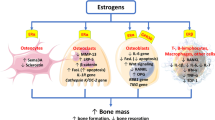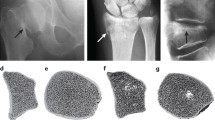Abstract
Type I osteoporosis occurs within 20 years after menopause and is associated with excessive cancellous bone loss and fractures of the vertebrae and distal radius. We have suggested that it may be caused by estrogen deficiency plus some additional factor predisposing to excessive bone loss. One such factor might be a greater degree of sex steroid deficiency, a possibility that could not be previously excluded because assays of sufficient sensitivity have only recently become available. Thus, we studied 36 women with vertebral fractures due to typical high turnover type I postmenopausal osteoporosis and 36 normal postmenopausal women using new ultrasensitive assays with detection limits of 1 pg/ml for estradiol, 5 pg/ml for estrone and 5 ng/dl for testosterone to test if type I osteoporosis results from enhanced responsiveness of bone to estrogen deficiency. Mean levels of serum sex steroids were identical in both groups, but bone turnover was increased by up to 55% in the women with type I osteoporosis. Moreover, compared with controls, the osteoporotic women had a 51% higher (P<0.01) serum osteoprotegerin level, which was likely a compensatory response to the increased bone turnover. In the osteoporotic women, 1-year treatment with transdermal estrogen in 14 women reduced total deoxypyridinoline, an index of bone resorption, by 58% as compared with placebo treatment in 17 women (P<0.001). Thus, as compared to controls, postmenopausal osteoporotic women had comparable sex steroid levels but higher bone turnover levels that were responsive to estrogen therapy. This is consistent with the hypothesis that the greater bone loss in type I osteoporosis is the result of impaired responsiveness of bone to low postmenopausal levels of sex steroids.

Similar content being viewed by others
References
Riggs BL, Melton LJ III (1983) Evidence for two distinct syndromes of involutional osteoporosis. Am J Med 75:899–901
Riggs BL, Khosla S, Melton LJ (2001) The type I/type II model for involutional osteoporosis: update and modification based on new observations. In: Marcus R, Feldman D, Kelsey J (eds) Osteoporosis. Academic Press, San Diego, pp 9–58
Riggs BL, Khosla S, Melton LJ (2002) Sex steroids and the construction and conservation of the adult skeleton. Endocr Rev 23:279–302
Eriksen EF, Hodgson SF, Eastell R, Cedel SL, O'Fallon WM, Riggs BL (1990) Cancellous bone remodeling in type I (postmenopausal) osteoporosis: quantitative assessment of rates of formation, resorption, and bone loss at tissue and cellular levels. J Bone Miner Res 5:311–319
Davidson BJ, Riggs BL, Wahner HW, Judd HL (1983) Endogenous cortisol and sex steroids in patients with osteoporotic spinal fractures. Obstet Gynecol 61:275–278
Marshall DH, Crilly RG, Nordin BEC (1977) Plasma androstenedione and oestrone levels in normal and osteoporotic postmenopausal women. Br Med J 2:1177–1179
Riggs BL, Ryan RJ, Wahner HW, Jiang N, Mattox VR (1973) Serum concentrations of estrogen, testosterone and gonadotropins in osteoporotic and non-osteoporotic postmenopausal women. J Clin Endocrinol Metab 36:1097–1099
Lufkin EG, Wahner HW, O'Fallon WM, Hodgson SF, Kotowicz MA, Lane AW, Judd HL, Caplan RH, Riggs BL (1992) Treatment of postmenopausal osteoporosis with transdermal estrogen. Ann Int Med 117:1–9
Khosla S, Peterson JM, Egan K, Jones JD, Riggs BL (1994) Circulating cytokine levels in osteoporotic and normal women. J Clin Endocrinol Metab 79:707–711
Khosla S, Arrighi HM, Melton LJ III, Atkinson EJ, O'Fallon WM, Dunstan C, Riggs BL (2002) Correlates of osteoprotegerin levels in women and men. Osteoporos Int 13:394–399
Cummings SR, Browner WS, Bauer D, Stone K, Ensrud K, Jamal S, Ettinger B (1998) Endogenous hormones and the risk of hip and vertebral fractures among older women. N Engl J Med 339:733–738
Ettinger B, Pressman A, Sklarin P, Bauer DC, Cautley JA, Cummings SR (1998) Associations between low levels of serum estradiol, bone density, and fractures among elderly women: the study of osteoporotic fractures. J Clin Endocrinol Metab 83:2239–2243
Hofbauer LC, Khosla S, Dunstan CR, Lacey DL, Boyle WJ, Riggs BL (2000) The roles of osteoprotegerin and osteoprotegerin ligand in the paracrine regulation of bone resorption. J Bone Miner Res 15:2–12
Bekker PJ, Holloway D, Nakanishi A, Arrighi M, Leese PT, Dunstan CR (2001) The effect of a single dose of osteoprotegerin in postmenopausal women. J Bone Miner Res 16:348–360
Yano K, Tsuda N, Kobayashi F, Goto M, Harada A, Ikeda K, Higashio K, Yamada Y (1999) Immunological characterization of circulating osteoprotegerin/osteoclastogenesis inhibitory factor: increased serum concentrations in postmenopausal women with osteoporosis. J Bone Miner Res 14:518–527
Riggs BL, Arnaud CD, Jowsey J, Goldsmith RS, Kelly PJ (1973) Parathyroid function in primary osteoporosis. J Clin Invest 52:181–184
Hossain M, Smith DA, Nordin BEC (1970) Parathyroid activity and postmenopausal osteoporosis. Lancet 1:809–811
Gao P, Scheibel S, D'Amour P, John MR, Rao SD, Schmidt-Gayk H, Cantor TL (2001) Development of a novel immunoradiometric assay exclusively for biologically active whole parathyroid hormone 1–84: implications for improvement of accurate assessment of parathyroid function. J Bone Miner Res 16:605–614
Heshmati HM, Khosla S, Robins SP, O'Fallon WM, Melton LJ III, Riggs BL (2002) Role of low levels of endogenous estrogen in regulation of bone resorption in late postmenopausal women. J Bone Miner Res 17:172–178
Salmen T, Heikkinen A-M, Mahonen A, Kroger H, Komulainen M, Saarikoski S, Honkanen R, Maenpaa PH (2000) Early postmenopausal bone loss is associated with PvuII estrogen receptor gene polymorphism in Finnish women: effect of hormone replacement therapy. J Bone Miner Res 15:315–321
Acknowledgements
We wish to thank Ms. Kelly Hoey for her assistance with the assays and Ms. Sara Achenbach and Ms. Cynthia Crowson for assistance with data management. This work was supported by Grant AG-04875 and MO1 RR00585 from the National Institutes of Health, U.S. Public Health Service.
Author information
Authors and Affiliations
Corresponding author
Rights and permissions
About this article
Cite this article
Riggs, B.L., Khosla, S., Atkinson, E.J. et al. Evidence that type I osteoporosis results from enhanced responsiveness of bone to estrogen deficiency. Osteoporos Int 14, 728–733 (2003). https://doi.org/10.1007/s00198-003-1437-9
Received:
Accepted:
Published:
Issue Date:
DOI: https://doi.org/10.1007/s00198-003-1437-9




